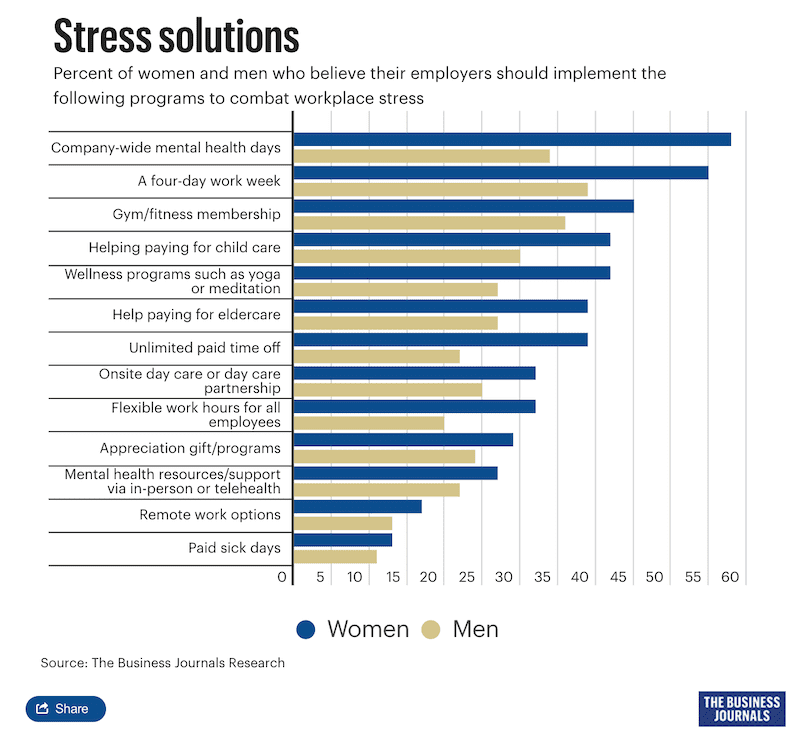There’s a disconnect between women and men on hybrid work

Women are more likely to work in hybrid office environments than men — and they also perceive more benefits from a hybrid setup.
That’s according to an exclusive new survey conducted by The Business Journals in conjunction with the 10th annual Mentoring Monday — a national event taking place Monday, Feb. 27, that is designed to be a catalyst for meaningful introductions and engaging conversations with businesswomen from a variety of industries.
The survey found 50% of women worked in hybrid offices, compared to just 44% of men. About 38% of men are in the office full time compared to 32% of women — and 18% of each are fully remote.
While men and women largely agree that being in a hybrid or remote setting has largely had no impact on their career, about 18% of men said it has hindered their career development, compared to just 12% of women.
Additionally, about 82% of women said they were better able to focus on their work goals without the distraction of an office environment, compared to 75% of men. About 29% of women said remote and hybrid work has given them more time with their supervisor to talk about their career and their work goals, compared to 18% of men.
The results are notable at a time when many businesses are calling employees back to the office more regularly or even ending their hybrid arrangements completely — in part due to concerns about a softening economy. The disconnect between men and women on hybrid work could create some challenges for businesses, as experts have noted employers should tread carefully with return plans that could disproportionately affect one class of workers.

Kate Field, the global head of health, safety and well-being at BSI, said there are a number of issues that illustrate the differences on hybrid work between men and women.
“I think there is an approach that is different in terms of genders’ ability to engage on a one-to-one basis. Women tend to be much more empathetic. They tend to be able to engage much more easily from a remote point of view,” Field said. “Men have been much more used to a traditional ‘looking each other in the eyes’ [environment] and the traditional hierarchies that go with those dynamics.”
Rosina Racioppi, president and CEO of WOMEN Unlimited Inc, a leadership development organization, said the gaps between men and women on the issue show how much work organizations have to do to close gaps in both mentoring and in overall workplace satisfaction.
While the pros and cons of hybrid work — and how it is viewed — are only one part of the equation, experts say the situation has highlighted some important distinctions.
“I think part of the challenge for organizations is that they are looking for the easy solutions, and this is a complex problem. Women are not one monolithic group, just like men are not one monolithic group,” Racioppi said. “Women tend to be more underrepresented and more marginalized in organizations because there isn’t representative senior leadership.”
Instead of jumping from trend to trend, Racioppi said companies need to focus on a concrete set of actions to improve company culture and then stick with it in the long term.
Part of that is training managers to understand that what worked for them in the past might not work for women in the often-hybrid, post-Covid workforce. Managers need to connect with workers proactively and have real conversations about how they feel about work, their role in the organization and what they want to do long term — or they risk those workers leaving for a new job in a labor market where opportunities remain abundant.
Racioppi said a lot of men will reach outside their work area or section and build networks that give them an understanding of how their work fits into the broader picture, while a lot of women she has worked with tend to focus on the work itself.
“Those relationships that look informal on the surface but are really part of their relationship building, it’s a much more casual way to build those relationships and women tend not to do that. They tend to do the work and not spend time on those relationships. They don’t know they are missing [in hybrid environments] because they have never had it in the first place,” Racioppi said.
Field said companies can help even the mentoring playing field by ensuring that workers are supported at each stage of their career with the company. New workers might need someone who can help them understand the role and their place in the company. Veteran workers might be more interested in how to grow and learn. Proactivity on those initiatives is very critical in a hybrid world where organic opportunities might not arise with the same regularity, experts say.
Formal programs can help, but also short training courses for workers on what a good mentor is and how they can help would benefit workers across a company, she added.
“Mentoring courses can be quite simple and straightforward, they are not months and months of intensive training or learning,” Field said. You can grow it organically. It kind of becomes a bit of a snowball. If it hasn’t been happening before it can be little bit slow, and you might have to do a bit of a mini-marketing campaign.”
This article originally appeared on the The Business Journal on Feb 21,2023.
